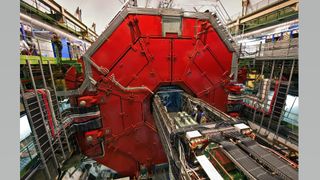Large Hadron Collider finds new way to measure mass of a quark

The ALICE experiment of the Large Hadron Collider has, for the first time, directly measured a phenomenon known as the "deadcone," which has allowed physicists to directly measure the mass of a fundamental particle known as a "charm quark."
Many particles that form the visible universe around us are actually composite particles built from less massive fundamental particles known as quarks. Protons and neutrons, for example, contain three quarks each. There are six different "flavors" of quark — up, down, top, bottom, strange and charm — which each have different masses, spins and other quantum properties. Different combinations of quarks also form different particles. The quarks are held together in these composite particles by the strong force, which is transmitted via a massless particle called a gluon. Collectively, quarks and gluons are known as 'partons'.
At the Large Hadron Collider (LHC) at CERN near Geneva, Switzerland, protons are accelerated by strong magnetic fields through a 16.8-mile(27 kilometers) tunnel to energies up to 6.8 TeV, before being smashed into one another. The collisions produce a cascade of other particles, which themselves emit or decay into even more particles, and so on in a cascade that can shed light on aspects of fundamental physics.
Related: 10 cosmic mysteries the Large Hadron Collider could unravel
In particular, quarks and gluons are produced and emitted in a cascade called a parton shower, where quarks emit gluons, and gluons themselves can emit other, lower-energy gluons.
Scientists working on ALICE (its name is short for A Large Ion Collider Experiment) trawled through three years' worth of proton–proton collisions to find evidence for the dead cone. According to the theory of quantum chromodynamics, or QCD, which describes how the strong force works, the dead cone is a region where partons of a certain mass and energy are prevented from emitting gluons.
"It has been very challenging to observe the dead cone directly," ALICE spokesperson Luciano Musa said in a press statement.
Get the Space.com Newsletter
Breaking space news, the latest updates on rocket launches, skywatching events and more!

Part of the difficulty is that the dead zone can be filled with other subatomic particles created in the proton-proton collisions, while tracking the motion of a parton through the shower as it constantly changes direction is also tricky.
To solve this problem, scientists collaborating on ALICE developed a technique whereby they were able to rewind recordings of parton showers backwards in time, allowing them to work out where and when the by-products of the shower were emitted. In particular, they looked for showers that involved a charm quark. As they deconstructed these showers, the scientists found a region in the pattern of gluon radiation emitted during the parton showers where the emission of gluons was suppressed. This is the dead cone.
The finding is important not only because it verifies a prediction of QCD, but also because it now provides a direct opportunity to directly measure the mass of the charm quark, which theory and indirect measurements places at 1,275 +/-25 MeV/c^2. According to QCD, the dead cone is directly related to the mass of the parton, and massless particles cannot produce a dead cone.
"Quark masses are fundamental quantities in particle physics, but they cannot be accessed and measured directly in experiments because, with the exception of the top quark, quarks are confined inside composite particles," said Andrea Dainese, who is the ALICE physics coordinator.
Therefore, the discovery of the dead cone could pave the way for a new era of quark physics.
The results were published on May 18 in the journal Nature.
Follow Keith Cooper on Twitter @21stCenturySETI. Follow us on Twitter @Spacedotcom and on Facebook.
Join our Space Forums to keep talking space on the latest missions, night sky and more! And if you have a news tip, correction or comment, let us know at: community@space.com.

Keith Cooper is a freelance science journalist and editor in the United Kingdom, and has a degree in physics and astrophysics from the University of Manchester. He's the author of "The Contact Paradox: Challenging Our Assumptions in the Search for Extraterrestrial Intelligence" (Bloomsbury Sigma, 2020) and has written articles on astronomy, space, physics and astrobiology for a multitude of magazines and websites.
